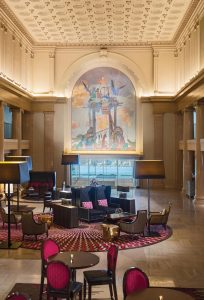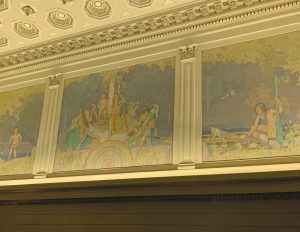
04 Jul Western Landmark: A tribute to Allen Tupper True
Historic preservation and adaptive reuse shape urban architecture across America. In Colorado, there are few examples as significant as the Renaissance Denver Downtown City Center Hotel, in part because this particular effort has saved a masterpiece by Colorado mural artist and illustrator Allen Tupper True [1881–1955].
Located in the former Colorado National Bank building, which was built in 1915 and now operates as a four-star boutique hotel, the Renaissance has made its mark as a significant cultural attraction. The makeover into a spacious and elegant hotel was careful to preserve the 16 oil-on-canvas murals by True, which were commissioned in 1923 and span the lobby perimeter at the mezzanine level. Looking up, the effect is transcendent, as the soft-colored paintings create an almost spiritual atmosphere.

Allen Tupper True’s narrative mural of Native American life overlooks the hotel’s lobby. A closer view is available from the mezzanine lounge.
“Many believe we have the most beautiful hotel lobby in Denver,” says hotel manager Michael Gayle.
Credit for this stellar remodel into a property that includes 230 rooms, conference spaces, a café, lobby bar, fitness center, and restaurant belongs to Navin Dimond, founder and CEO of Stonebridge Companies, a Denver-based hotel development firm with more than 160 properties in its portfolio. “From boutique hotels of four stories to larger ones with 40, none of my acquisitions to date carries the dignity, significance, or importance of this particular jewel,” says Dimond. “I find value in repurposing a building over 100 years old; a building that will endure. It’s a kind of stewardship.”
The murals by True, collectively titled Indian Memories, are grouped into five triptychs depicting a Native American man’s life: Youth, Buffalo Hunt, War, Women, Art Work and, high above the main entrance, the largest panel, Happy Hunting Ground, which portrays the subject’s final journey surrounded by his shield, saddle, and life memories. Faithful to the artist’s illustrative approach to painting, the subject matter is handled in an idealized and heroic form.

In the final panel installed above the main entrance, a deceased Native American chief lies surrounded by his shield and lance as his soul is escorted to the world beyond by flying cranes. Photos courtesy of the Renaissance Denver Downtown City Center Hotel
True was deeply rooted in the West, born in Colorado Springs and raised in Texas and Mexico before his family settled in Denver. According to the book Murals of Colorado: Walls that Speak by Mary Motian-Meadows and Georgia Garnsey, True deeply respected Native Americans whom he believed were cruelly treated by the U.S. government.
Colorado historian and architect Jim Barrett has extensively researched the artist and reminds us that True wanted his art to be permanent. Murals facilitated a way for the work to endure. Further, he dreamed of using Native American iconography in a bigger way, as a form of architectural ornament or part of a visual surface vocabulary. In one memorable example, his design for the terrazzo floor at the Hoover Dam were based on Native American pottery and sand paintings.
Over his career, True painted commissions for government buildings, hotels, and private businesses primarily with the subject he loved most — the changing nature of life in the West. The most prolific of artists whose work is accessible to the public, True’s murals have been on view in the state capitals of Colorado, Wyoming, and Missouri, as well as Denver’s public library and county courthouse. A walk around downtown Denver reveals outstanding examples at the nearby Brown Palace Hotel and former Mountain States Telephone Building.

The hotel’s restaurant, Range, offers a convenient getaway for lunch, cocktails, or dinner. By day, it’s bright and inviting, while evenings offer a more romantic, secluded atmosphere. Photos courtesy of the Renaissance Denver Downtown City Center Hotel
Listed on the National Register of Historic Places, the original building that now houses the Renaissance was designed by Denver architects William and Arthur Fisher. Once deemed “a bank that looks like a bank,” the four-story Neoclassical Greek Revival is both monumental in scale and dignified in appointment. It crowned Denver’s financial district, the “Wall Street of the Rockies.” In 1925, the bank doubled in width and was extended considerably in length. In the ’60s, two more stories were added, and an existing skylight was turned into a semi-open rotunda.
U.S. Bank acquired the property in 1998 but vacated the building shortly thereafter. Empty and in disrepair, it was purchased by Stonebridge in 2011. New construction completed in May 2014 added two more stories for a total of eight. The rotunda was also enclosed, preventing access to the murals for seven years but preserving them for the future. To credit the creative remodel, three former bank vaults that once housed gold bullion and other precious metals, complete with their original massive doors, were converted into meeting spaces.
For the lucky traveler, the hotel’s ground floor restaurant, Range, offers New American Western cuisine under Executive Chef Steven Yacovetta with dishes like buffalo ravioli and chili-laced dark chocolate mousse. And the Teller Bar in the lobby has become a downtown meeting place. But regardless of where the viewer stops to rest, relax, or dine, the spirit of Allen Tupper True’s most dreamlike work infuses the space, making it one worth visiting again and again.
Corinne Joy Brown is an award-winning, Colorado-based freelance writer and novelist. A former staff writer for the National Cowboy and Western Heritage Museum’s publication Persimmon Hill, she currently covers art, design, and architecture for Colorado Life, Home & Garden Colorado, and other regional publications; corinnejoybrown.com.






No Comments